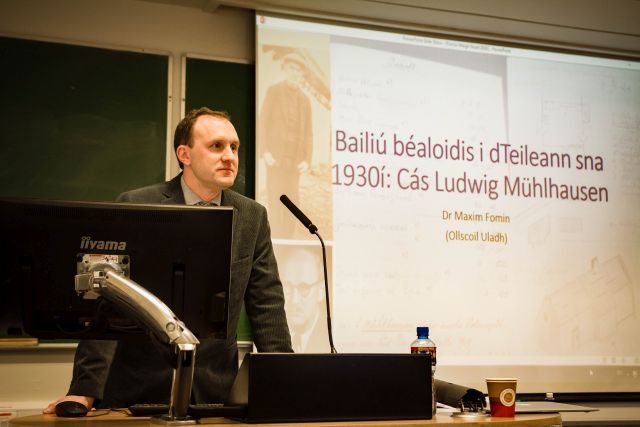14.09.2020
"We know that vernacular oral narratives are deeply rooted in traditional communities."
In Conversation with Research Alumnus Dr. Maxim Fomin, Research Director of Modern Languages and Linguistics Research Unit at the Faculty of Arts, Humanities and Social Sciences at Ulster University, Northern Ireland
What is your connection with Tübingen and the University?
I arrived in Tübingen in September 2015 to look at the collection of Irish fairy tales Professor Ludwig Mühlhausen had collected in Donegal in 1937. This collection is kept in the Manuscripts Department of the University Library. I came as a guest of Professor Bernhard Maier, Chair for Religious Studies at the University and was also supported by Dr. Wilfried Lagler, Chief Librarian at the Department. Professor Maier hosted me between May 2016 and October 2017. My research was generously funded by the Alexander von Humboldt Foundation through the award of Experienced Researcher’s Fellowship. As Humboldt Fellow, I gave a talk at the former Forum Scientiarum, now Center for Interdisciplinary and Intercultural Studies, on "The Irish Folklore Tradition: Then and Now" (Humboldt Lecture Series December 2016) and the Tübingen branch of the German Society of Humboldtians invited me and my son David to a trip to Stuttgart on 22 October 2016. We went to see the chapel on Württemberg hill (also known as Württemberg Mausoleum in Rotenberg) erected by King Wilhelm I in memory of his wife Katharina (born Catherine Pavlovna Romanoff, the sister of the Russian emperor Alexander I). The highlight of the visit was the opportunity to see the icons on display as they had originally come from the Russian city of Tver where I was born.
Where are you based?
I am Research Director of Modern Languages and Linguistics Research Unit at the Faculty of Arts, Humanities and Social Sciences at Ulster University, Magee campus, City of Derry, Northern Ireland.
What is your recent publication about?
The monograph Ludwig Mühlhausen, Séamus Ó Caiside and Scéal Rí na Gréige: The Tale of 'Three Golden Children' (ATU 707) in 1937 Donegal is the result of my stay in Tübingen, where I conducted research in the archives of Ludwig Mühlhausen, formerly Professor of Celtic Studies at the University of Berlin. Between 25 August and 13 October 1937, Mülhausen stayed in the Irish-speaking village of Teelin (Co. Donegal), and recorded 12 tales and two songs from a local storyteller, Séamus Ó Casaide. On his return to Germany, ten tales collected from Ó Caiside were published as Zehn irische Volkserzählungen aus Süd-Donegal. Of the tales the scholar chose not to publish, one called "Scéal Rí na Gréige" ("The Tale of the King of Greece") falls within the focus of my study. "Scéal Rí na Gréige" presents a version of the well-known international folktale type ATU 707: "Three Golden Children". I examine the type’s dissemination in Ireland, and its four ecotypes. Despite its wide distribution, my main argument is that the story known to Ó Caiside came from the printed medium – from a popular version of The Arabian Nights Entertainments. To be understood by the Irish-speaking audience, the story was rendered into the vernacular; yet, its key elements were articulated in English, embellishing the plot with a flavour of exoticism and of the Orient. "Scéal Rí na Gréige", a unique folklore product, married the Irish vernacular to the European print culture, signifying an innovative step in the development of the Irish oral tradition.
What fueled your interest in this topic?
We know that vernacular oral narratives are deeply rooted in traditional communities. In rural Ireland they existed alongside printed texts available in newspapers, chapbooks and pamphlets - the products of the industrialised society of the late nineteenth-early twentieth century. Traditionally, it is believed that folk stories were reproduced from the storyteller’s memory for the audience. The situation radically changed with the introduction of the printed medium that facilitated the reading of tales aloud from a book. The Irish oral tradition has previously been viewed as laid back and immersed in time, owing its rich content to the generations of storytellers who learned their trade from their forefathers, the method aptly described in the Irish phrase "ó ghlúin go glúin" (lit. "from knee to knee", fig. "from generation to generation"). I have strived to argue that this was not the case, that the Irish storytellers were perfectly capable of creating new folktales by adapting those widely available in print into Irish. The interest of Irish storytellers in the tales from The Arabian Nights Entertainments was especially prominent and "Scéal Rí na Gréige" is a case study of this phenomenon.
Fun fact: Mühlhausen became a figure of local lore
In the old days, the Irish fishermen could not swim. Mülhausen left a lasting legacy on the Teelin locals due to his habit of going for a swim every morning in the cold waters of the North Atlantic. On his first day, he took a plunge and people present thought he had drowned. A few minutes later, they realised that he had come ashore in a different place as he started helping them to look for the "drowned man" (the story was told as part of the local lore in 2019)!

